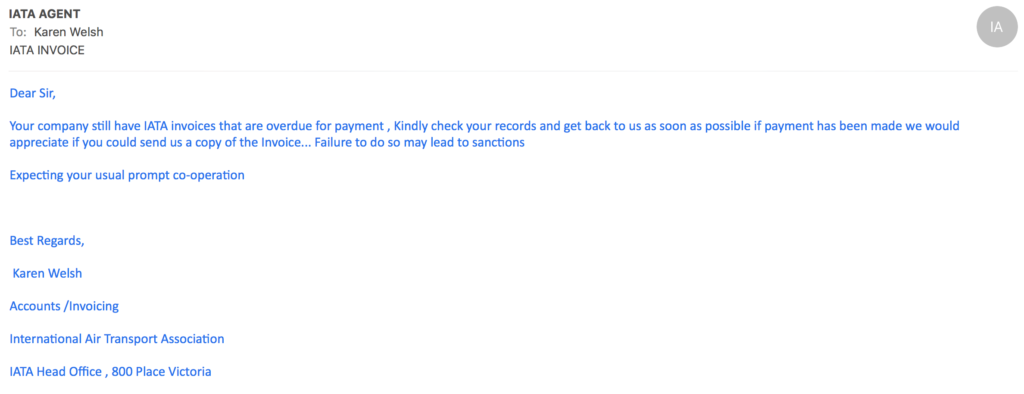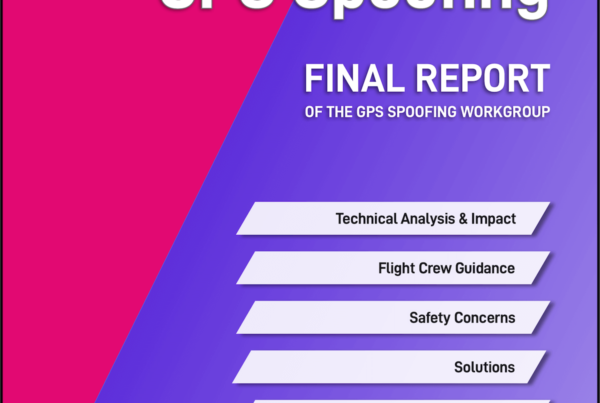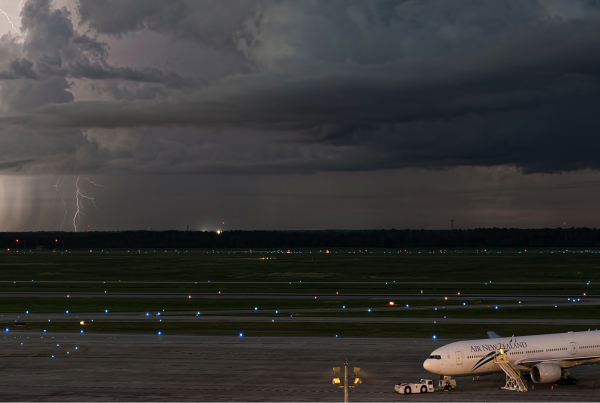It’s a concern: instead of sending your Nav Fees payment to Eurocontrol, you’ve actually sent it to some guy sitting in his underpants in his mother’s basement. And you’re not going to get it back.
We’ve seen an increasing variety of scam emails, that at first glance look like they are from Eurocontrol – but aren’t. Here’s a good example from this week:
 You’d be forgiven for glancing over it and responding to request the details of ‘their’ new bank account. And that’s where the problem begins – you’ll get a new bank account, only it won’t direct your money to Brussels.
You’d be forgiven for glancing over it and responding to request the details of ‘their’ new bank account. And that’s where the problem begins – you’ll get a new bank account, only it won’t direct your money to Brussels.
IATA has the same issue:
 Fortunately, most of these emails are poorly written, and easy enough to identify as bogus – but that’s only if you are on your guard. The best solution is to simply be aware of the risk:
Fortunately, most of these emails are poorly written, and easy enough to identify as bogus – but that’s only if you are on your guard. The best solution is to simply be aware of the risk:
Eurocontrol
- Look at the sender address: real emails come from eurocontrol.int. Fake ones look similar, but might be something like @eurocontrolinc.com or @eurocontrolint.in.
- Most of the emails ask for a copy of an invoice or payment – be suspicious when you read that.
- Be especially alert when the email mentions a change in bank account. Eurocontrol has no plans to change bank accounts any time soon.
- Best advice: write to the real address: r3.crco@eurocontrol.int and ask for confirmation of any message, or call the Route Charges office on +32 2729 3838.
- The most secure way to handle Eurocontrol charges and payments is through their CEFA portal.
IATA
- Most recent fake addresses: invoice@iatahelpdesk.org, payments@iataaccounting.org
- Contact the real address: information.security@iata.org
The Air Charter Association have also warned that scammers have recently targeted business deals where operators charter out their aircraft to brokers. Similar to the fake IATA invoices scam, but more elaborate. Bottom line, if you’re chartering out your aircraft — or if you’re chartering one yourself — work with a reputable broker and triple-check all contact details (email addresses as well as phone numbers) and bank account details before pushing the button on any money transfers.
Even the mighty Japan Airlines fell victim to a targeted email scam back in 2017 which defrauded the company of JPY384 million yen – the equivalent of around USD $3.4 million. The airline received a series of emails purporting to be from a U.S. financial services company that had been leasing aircraft to Japan Airlines. Not realising it was scam, JAL promptly paid the money into a Hong Kong bank account, as requested. It was only later discovered to be fraudulent, when the genuine U.S. company demanded payment!
Have you been the target of similar scams? Let us know! – and we’ll add it to the list of dodgy email addresses and common scams.
More on the topic:
- More: Summer Tips for Flight Planning in Europe
- More: Computer Says No: Why FAA RVSM Approvals Matter in Europe
- More: UK Air Passenger Duty Rate Hike
- More: Big Summer Slots (a Storybook)
- More: Please be Wary of Malicious Phish
More reading:
- Latest: Crossing the Quiet South: From Australia to Argentina
- Latest: Major runway shutdowns ahead at KVNY/Van Nuys
- Latest: New FAA Airspace Warnings for Venezuela and Puerto Rico
- Safe Airspace: Risk Database
- Weekly Ops Bulletin: Subscribe
- Membership plans: Why join OPSGROUP?











 Get the famous weekly
Get the famous weekly 





Hi Declan
Many thanks for raising awareness about these “fake navigation fees”. I’m in charge at EUROCONTROL of the EATM-CERT and one of our duty is to help aviation stakeholders not being victims of such scams.
I have some slight concerns about your article as best practices when releasing publicly (this web page is open to anyone) such examples are to blur names and usable information such as invoice references, unit name.
If you want to know more about what we have achieved so far in fighting those scams, please contact me.
Many thanks again for raising awareness
Patrick MANA
EUROCONTROL
EATM-CERT Manager